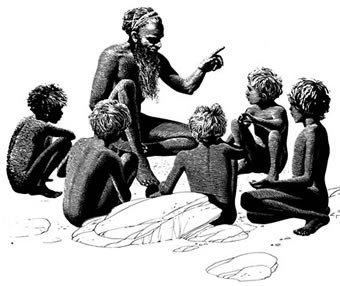Dreamtime: The Heart of Indigenous Culture and Spirituality
Dreamtime: The Heart of Indigenous Culture and Spirituality

The concept of Dreamtime, a term used by many Aboriginal Australian cultures, is not merely a time in the past. It’s a timeless, interwoven tapestry of stories, beliefs, and practices that forms the very foundation of Indigenous Australian spirituality, culture, and identity. This profound concept, often referred to as "The Dreaming," transcends the boundaries of time, connecting the past, present, and future, and shaping the lives of Aboriginal Australians for millennia.
Understanding Dreamtime:
Related Articles: Dreamtime: The Heart of Indigenous Culture and Spirituality
- A Tapestry Of Connection: How Aboriginal Peoples Used The Land
- Unmasking The Soul: Exploring The Rich History And Significance Of Aboriginal Masks
- The Whispers Of Creation: Unpacking The Sacred Instructions Of Australia’s First Peoples
- Embrace The Aussie Outback: Choosing Non-Invasive Root Trees For Your Garden
- Unveiling The Mysteries: A Journey Through The Sacred Symbols Of Aboriginal Culture
Dreamtime is not a singular event but an ongoing, living, and evolving reality. It’s a realm where ancestral beings, known as "spirit ancestors," created the world, its landscapes, its creatures, and the laws that govern them. These ancestral beings, often represented in intricate rock art and oral traditions, continue to interact with the present world, influencing everything from the weather to the growth of plants, and even the relationships between people.
The Creation Story:
At the heart of Dreamtime lies the creation story, a complex narrative that explains the origin of the universe, the land, and the people. It’s not a static story but a dynamic one, constantly being retold and reinterpreted by each generation. Through these stories, Aboriginal Australians learn about their ancestral heritage, their connection to the land, and their responsibilities as custodians of the natural world.
The Importance of Land:
Dreamtime stories are intrinsically linked to specific locations. Each rock formation, river, mountain, and even tree holds a story, a memory of the ancestral beings who shaped the land. This deep connection to the land is a fundamental aspect of Aboriginal culture, emphasizing the importance of respecting and caring for the natural world.
The Role of Art and Ceremony:
Dreamtime stories are not just words; they are embodied in the vibrant arts and ceremonies of Aboriginal cultures. From intricate rock art and sand paintings to dances, songs, and storytelling, these artistic expressions serve as powerful reminders of the Dreamtime and its teachings. Ceremonies, often held at sacred sites, act as a bridge between the physical and spiritual worlds, allowing people to connect with their ancestors and reaffirm their cultural identity.
The Ongoing Relevance of Dreamtime:

Dreamtime is not a relic of the past; it is a living force that continues to guide Aboriginal Australians today. Its principles inform their understanding of the world, their relationships with each other, and their responsibilities to future generations.
Dreamtime and Sustainability:
The Dreamtime philosophy, with its emphasis on interconnectedness and respect for the environment, offers valuable insights for a world grappling with environmental challenges. The concept of custodianship, which emphasizes the responsibility of caring for the land for future generations, resonates with modern concerns about climate change and sustainable living.
Dreamtime and Reconciliation:
The Dreamtime is also a powerful symbol of cultural resilience and survival. It has endured for millennia, despite colonization and the challenges faced by Indigenous Australians. Understanding Dreamtime is crucial for fostering reconciliation between Indigenous and non-Indigenous Australians, acknowledging the richness and depth of Aboriginal culture and its enduring legacy.

FAQs about Dreamtime:
Q: What is the difference between Dreamtime and the Dreaming?
A: While both terms are used interchangeably, "Dreamtime" often refers to the specific time period in the past when ancestral beings created the world, while "The Dreaming" encompasses the ongoing, living reality of the ancestral beings and their influence on the present.
Q: Can anyone experience Dreamtime?
A: While Dreamtime is a fundamental part of Aboriginal culture, it’s not a concept that is easily accessible to outsiders. It requires deep understanding, respect, and immersion in Aboriginal traditions and beliefs.

Q: Is Dreamtime a religion?
A: Dreamtime is not a religion in the traditional sense. It’s a complex system of beliefs and practices that encompass spirituality, cosmology, cultural identity, and law.
Q: How can I learn more about Dreamtime?
A: The best way to learn about Dreamtime is to engage with Aboriginal communities, attend cultural events, and read books and articles written by Indigenous authors and scholars.
Q: Why is Dreamtime important today?
A: Dreamtime is a vital part of Aboriginal culture, providing a framework for understanding the world, connecting with ancestors, and guiding future generations. It offers valuable lessons for sustainability, reconciliation, and living in harmony with the natural world.
Dreamtime: A Timeless Legacy
Dreamtime is not just a story; it’s a way of life. It’s a living, breathing connection to the past, present, and future, a testament to the resilience and wisdom of Indigenous Australian culture. By understanding Dreamtime, we can gain a deeper appreciation for the rich tapestry of human experience and the profound interconnectedness of all things.

Closure
Thus, we hope this article has provided valuable insights into Dreamtime: The Heart of Indigenous Culture and Spirituality. We thank you for taking the time to read this article. See you in our next article!


